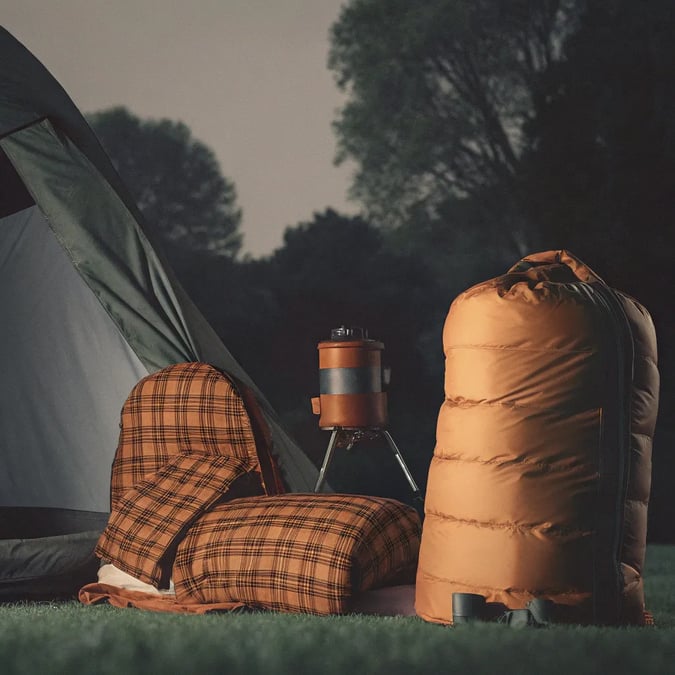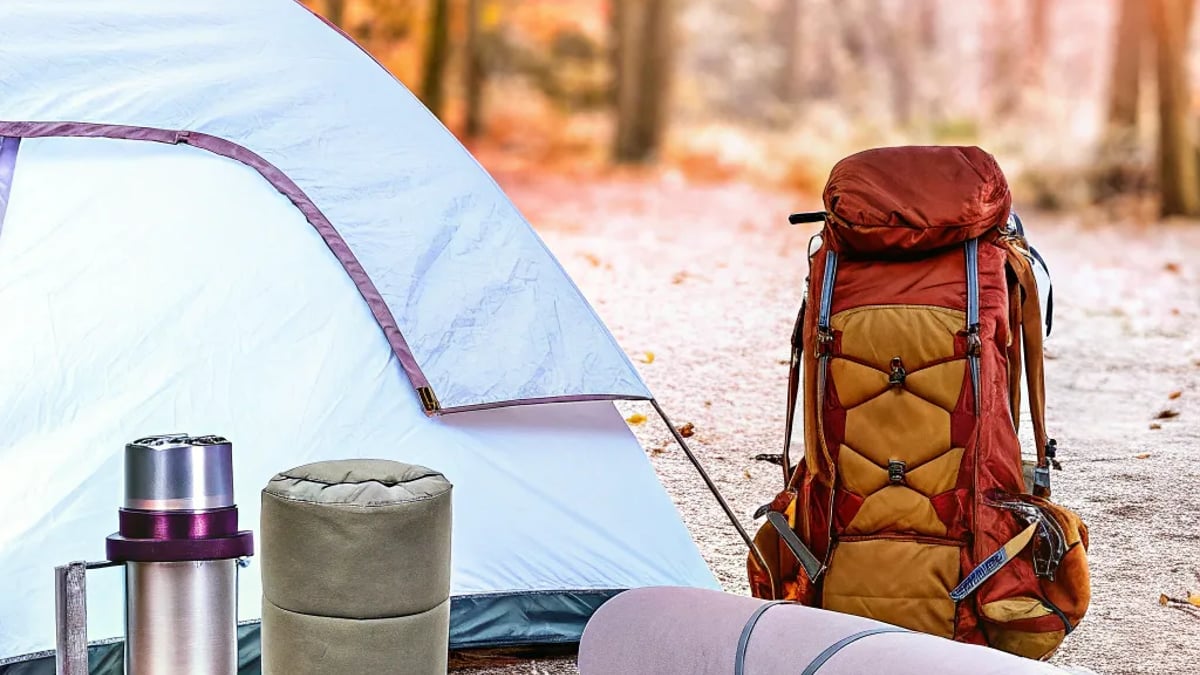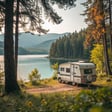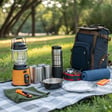
The crisp autumn air, vibrant foliage, and fewer crowds make fall one of the most rewarding seasons for camping. But as temperatures fluctuate and weather becomes less predictable, having the right gear becomes even more crucial. I've spent the last three weekends testing equipment in the Adirondacks, and I'm ready to share what's worth your investment for fall 2025.
Weather-Ready Shelter Systems
When I started camping in fall years ago, I learned the hard way that summer tents don't always cut it when October winds kick up. The shelter systems of 2025 have evolved dramatically to address the specific challenges of shoulder season camping.
Next-Generation Tents
The standout this season is the Mountain Hardware Aspect 3, which balances weight and weather resistance masterfully. At just under 4 pounds, it's not ultralight, but the reinforced pole structure handled 30 mph gusts during my test without so much as a flutter. The rainfly extends nearly to the ground—a feature I've come to appreciate after a particularly damp night last October.

For solo adventurers, the Big Agnes Scout Carbon has reinvented the traditional bivy. Using their new carbon-composite poles, they've created a 1.7-pound wonder that sets up in literally 90 seconds (I timed it) while providing surprising interior space. The vestibule is still tiny though, so plan accordingly for gear storage.
Worth mentioning is the continued evolution of REI's Quarter Dome series. The 2025 model incorporates their "thermal barrier" technology—essentially a reflective layer that genuinely seems to retain 3-5 degrees more warmth than previous versions. Not revolutionary, but noticeable on chilly mornings.
Groundwork Improvements
Your tent is only as good as what's beneath it. The Nemo Chipper has become my go-to sleeping pad for fall. Its R-value of 4.3 provides sufficient insulation from the increasingly cold ground, while the "quiet cell" technology actually delivers on the promise of less crinkly noise when you shift at night.
Don't forget a proper footprint—the Granite Gear Toughprint isn't the lightest option, but its durability makes it worth the extra few ounces when setting up on unknown terrain with fallen branches and sharp rocks hiding under those beautiful autumn leaves.
Sleep Systems for Dropping Temperatures
Nothing ruins a fall camping trip faster than shivering through the night. Sleep systems have seen some of the most innovative improvements in the 2025 lineup.
The REI Magma 15 sleeping bag remains hard to beat for its warmth-to-weight ratio, but this year's update includes a redesigned hood that cradles your head more effectively. The zipper still occasionally snags—some things never change.
For those who hate the constriction of mummy bags, the Enlightened Equipment Revelation quilt (custom 20°F version) has become my personal favorite. The pad attachment system has been refined to eliminate drafts—the previous weakness of most quilts. It packs down to the size of a large grapefruit and weighs just 22 ounces with the latest DownTek water-resistant fill.
If you're camping in areas where temperatures might drop below freezing, don't overlook the importance of a sleeping bag liner. The Sea to Summit Reactor Extreme adds a claimed 25°F of warmth, though in my experience it's closer to 15°F—still significant when temperatures plummet unexpectedly.
Cooking and Hydration: Fall Edition
Fall camping often means longer evenings at camp, making cooking more enjoyable than during summer's heat. The cooking gear landscape has seen some practical innovations for 2025.
Stove Systems
The Toaks titanium stove has become a game-changer for backpackers. It collapses to the size of a bean can and burns wood fuel, eliminating the need to carry heavy gas canisters. During my testing, it boiled water in about 4.5 minutes in calm conditions—not the fastest, but the weight savings and unlimited fuel source make it worth considering.
For those who prefer the reliability of gas, the MSR PocketRocket Deluxe still reigns supreme for its balance of weight, simmer control, and wind resistance. The integrated igniter has proven more durable than previous iterations—I'm on my 45th use without failure.
What's surprised me most is the resurgence of alcohol stoves. The Trangia Spirit Burner paired with their new heat exchanger pot boils water with remarkable efficiency. It's silent operation feels almost meditative compared to the roar of pressurized gas stoves.
Water Solutions
Fall camping often means fewer reliable water sources as seasonal streams dry up. The Platypus QuickDraw microfilter system has quickly become my preferred filtration method. It weighs just 3.3 ounces and filters a liter in about 60 seconds. The flow rate has remained consistent even after filtering silty water—something that clogged my previous filter.
For camp cooking and coffee, I've found the Sea to Summit X-Pot Kettle to be perfectly sized for 2-3 campers. Its collapsible design saves valuable pack space, and the silicone sides have shown no signs of degradation despite repeated exposure to open flame (though the manufacturer still recommends caution).
Power Management for Connected Camping
Even when seeking solitude in nature, most of us still rely on devices for navigation, photography, or emergency communication. Power management has become increasingly important for responsible backcountry travel.
The power bank landscape has evolved significantly, as detailed in a recent Reddit analysis of ultralight options. The standout for 2025 is Anker's new model featuring a built-in wall plug and 30W passthrough charging. This eliminates the need to carry a separate wall adapter, saving both weight and space.
For those venturing on longer trips, portable solar options have become more viable. The BioLite SolarPanel 10+ with its integrated kickstand and power bank has proven surprisingly effective even in partial sun. During testing, it generated enough power to keep my phone, headlamp, and satellite communicator charged during a four-day trip.
Clothing Strategy for Fall's Fickle Weather
Fall demands a more sophisticated clothing approach than summer's simplicity. Layering becomes essential as temperatures can swing 40 degrees from day to night.
Base Layers Worth the Investment
Smartwool's Merino 250 base layers remain my go-to foundation. They're not cheap, but after testing dozens of alternatives, nothing matches their combination of warmth, odor resistance, and durability. I've had my current set for three seasons with minimal signs of wear.
For those seeking a synthetic alternative, the Patagonia Capilene Air has finally achieved what seemed impossible—a synthetic fabric that approaches merino's comfort while drying noticeably faster. The 3D knit structure creates effective dead air space for warmth without bulk.
Mid-Layer Innovations
The fleece mid-layer has seen a renaissance with Polartec's new Alpha Direct fabric. The Mountain Hardwear Airmesh Hoody weighs just 9 ounces but provides remarkable warmth for its weight. It's also the most breathable mid-layer I've tested, preventing the dreaded "swamp effect" during active hiking.
For those prioritizing packability, the Enlightened Equipment Torrid jacket filled with Climashield APEX remains hard to beat. Mine compresses to the size of a softball and provides warmth equivalent to a much heavier fleece.
Outer Layer Essentials
Your shell layer becomes critical as fall progresses. The Outdoor Research Helium Rain Jacket has been refined yet again for 2025, now offering improved breathability while maintaining its sub-7-ounce weight. The adjustable hood finally provides adequate coverage without restricting visibility—a common problem with ultralight rain shells.
For pants, I've become a convert to the quick-drying, stretchy synthetic options from Prana. Their Stretch Zion II pants shed light rain, dry quickly after heavier downpours, and provide enough warmth when paired with a base layer for most fall conditions.
What Do I Really Need for Fall Camping?
The most common question I get from readers is: "What's actually essential for fall camping?" While comprehensive camping checklists are helpful, here's my minimalist take based on years of experience:
- Temperature-appropriate sleep system - This is your non-negotiable foundation. A sleeping bag/quilt rated 10°F below your expected nighttime lows.
- Reliable shelter - Four-season tents are overkill for most fall conditions, but ensure your three-season tent has a full rainfly and solid stake-out points.
- Insulated sleeping pad - An R-value of at least 3.5 is recommended for fall conditions.
- Layered clothing system - Base layer, insulating mid-layer, and waterproof/windproof outer layer at minimum.
- Adequate water storage & filtration - Capacity for at least 2 liters plus a reliable filtration method.
- Efficient cooking system - Simple is often better; a stove that performs well in wind is crucial.
- Headlamp with fresh batteries - Fall's shorter days mean more time in darkness.
- Navigation tools - Map, compass, and/or GPS device with power backup.
- First aid kit - Customize for your specific needs and trip duration.
- Emergency communication device - Cell service is unreliable in many camping areas.
Ultralight Innovations Worth Considering
The ultralight movement continues to influence mainstream camping gear, with some innovations becoming practical enough for casual campers. According to various camping gear wholesalers and trending products for 2025, these ultralight innovations are crossing into the mainstream:
The Gossamer Gear Mariposa backpack has finally achieved the seemingly impossible—comfort with loads up to 35 pounds while weighing just under 2 pounds itself. The redesigned shoulder straps distribute weight more effectively than previous ultralight packs.
Titanium continues to dominate the ultralight cookware scene, with Snow Peak's Trek 700 mug/pot combo remaining the gold standard for solo campers. Its versatility as both cooking pot and eating vessel eliminates the need for separate dishes.
For those concerned about weight but unwilling to sacrifice comfort, the Therm-a-Rest NeoAir XLite has been updated with quieter materials while maintaining its impressive 4.5 R-value and 12 oz weight. It's an investment at around $200, but one that pays dividends in both pack weight and sleep quality.
Budget-Friendly Alternatives That Perform
Not everyone can afford premium gear, and thankfully there are excellent budget options for fall camping. I've been impressed by Decathlon's steady improvement in quality while maintaining affordable prices.
Their Trek 900 1-person tent offers remarkable weather protection at just $130—about one-third the price of premium alternatives. It's about a pound heavier than high-end options, but the build quality suggests it will last for many seasons.
For sleeping bags, the Kelty Cosmic 20 (down version) remains the value benchmark. At around $170, it's significantly less expensive than competitors while using 550-fill down that provides reliable warmth and reasonable packability.
On the cooking front, BRS has disrupted the market with their ultralight canister stove priced under $20. While it lacks the refinement and wind resistance of premium stoves, it's perfectly functional in protected cooking areas and weighs just 25 grams.
Final Thoughts: Investing Wisely for Fall 2025
As I organize my gear for next weekend's trip to the White Mountains, I'm reminded that the best camping investments focus on three critical systems: sleep, shelter, and clothing. These directly impact both safety and enjoyment.
The rest—cooking equipment, accessories, and gadgets—can be upgraded incrementally as budget allows. A simple alcohol stove can boil water just as effectively as a $150 integrated canister system, even if it takes a minute longer.
What's your essential fall camping gear? Have you tried any of the 2025 innovations mentioned? I'd love to hear about your experiences in the comments below. The camping community grows stronger when we share our successes and failures with gear in the field.
Until next time, happy trails and warm nights!
Tags

About Evan Ridgewell the Author
Evan Ridgewell is a seasoned hiking enthusiast with over a decade of experience traversing the world's most challenging trails. His in-depth reviews of hiking gear focus on durability and performance in extreme conditions, making him a trusted source for outdoor adventurers.
Recommended Articles
Arthritis Creams People Swear By for Real Relief
Discover popular arthritis creams that provide effective relief from joint pain and inflammation. Find out which ingredients to look for!
Early Buyers Say This Tiny Camper Changed Their Weekend Trips
Discover how tiny campers enhance weekend adventures with freedom, comfort, and affordability. Hear from early buyers who embraced the lifestyle.
These Clever Camping Gadgets Will Change How You Pack
Explore innovative camping gadgets that simplify packing and enhance your outdoor experience with essential gear for your next adventure.
The Tiny Camper Trend That’s Exploding in 2025
Discover the tiny camper trend in 2025, focusing on sustainable adventure and space-efficient designs for modern travelers.
Drama Movies That Moved Audiences: Critically Acclaimed List
Discover a list of drama films that have not just entertained but profoundly moved audiences, redefining cinema with their powerful storytelling and emotional depth. From timeless classics like "Schindler's List" to contemporary masterpieces such as "Moonlight" and "Parasite," this captivating article explores how these films connect us through universal human experiences, making them unforgettable and eternally relevant.




